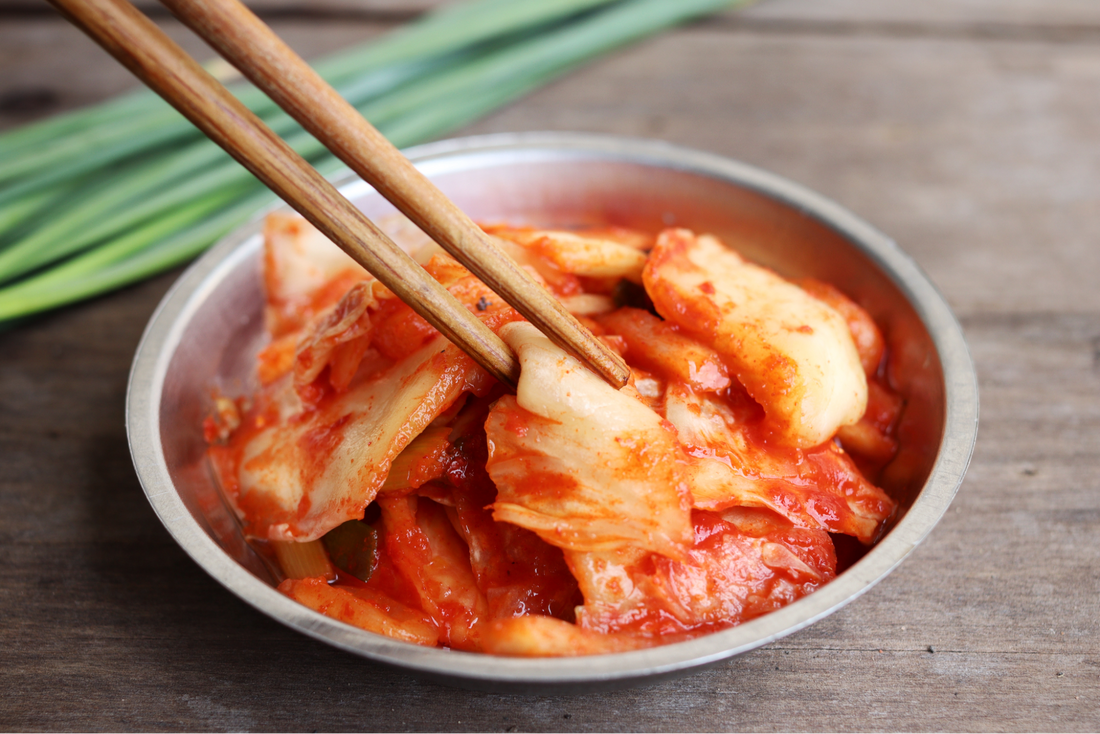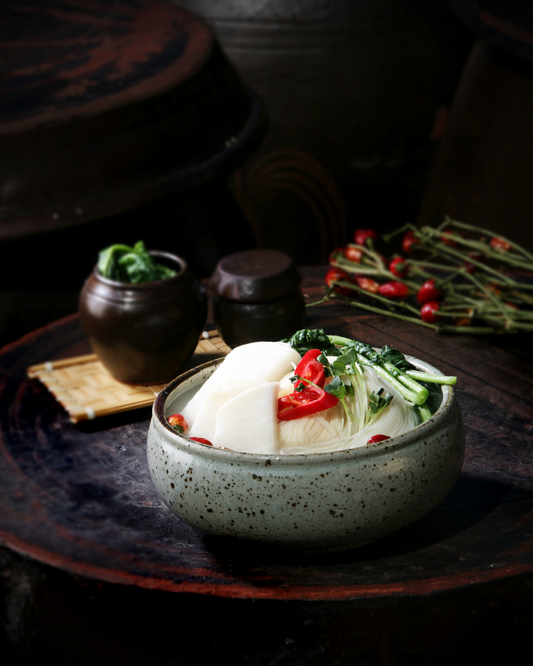Scientific Changes in Flavor, Aroma, and Texture During the Fermentation Process of Kimchi

Have you ever wondered how ordinary cabbage turns into delicious kimchi? The science of fermentation is key. It shapes the flavor, aroma, and texture of kimchi that people love. This process is central to kimchi and culinary traditions around the world.
The kind of cabbage and fermentation temperature can affect the microbial community. This leads to the unique flavors of kimchi. The scientific approach to fermentation gives us many tastes and textures. So, what makes the perfect kimchi? Maybe the answer lies in how we store and ferment it.
Research shows that cabbage stored before making kimchi ferments faster. This is in comparison to using fresh cabbage. It also creates a unique microbial community. This influences the sweetness, texture, and rich lactic acid flavor in kimchi.
Key Takeaways
- Korean culinary tradition expresses itself through the complex science of kimchi fermentation, affecting taste, aroma, and texture.
- Stored cabbage accelerates the fermentation process in early to mid-stages, profoundly shaping the changes in kimchi flavor.
- Scientific analysis highlights the importance of adjusting fermentation variables like temperature and time to perfect kimchi quality.
- Moisture and sugar levels, influenced by storage conditions, are crucial for developing the aroma and texture of kimchi.
- Control kimchi's distinct sweetness and texture illuminate the nuanced effects of ingredient selection and fermentation techniques.
- Scientific tests, including pH, microbial counts, and sensory evaluation, are indispensable for understanding the fermentation process.
- Optimal kimchi fermentation involves a fine balance that can be navigated through informed understanding of microbial behavior and metabolite changes.
The Magic of Fermentation
Kimchi's unique taste comes from the ancient process of fermentation. This is thanks to fermentation microorganisms. These tiny organisms, especially lactic acid bacteria, change simple cabbage into a world-famous dish. The principles of fermentation explain that these bacteria love salty places. This keeps away bad bacteria, making kimchi safe to eat all over the world.
Kimchi has over 200 different kinds. The making of each batch begins with the yeasts and bacteria on cabbage leaves. These microbes start the fermentation. They break down big starches into simple sugars. This is what gives kimchi its tangy taste. Salt levels and temperature are key. They pick out the good microbes and stop the bad ones.
Usually, kimchi quickly goes from fresh to ripe in a few days. This changes its taste, texture, and smell. Some like their kimchi fresh and crisp, others love it fully fermented. The longer kimchi ferments, the richer its taste. This aged kimchi is great for making dishes like Kimchi Jjigae.
Keeping the right temperature is crucial for fermenting kimchi. This stops bad bacteria but lets lactic acid bacteria grow at cool temperatures. It's all about making good flavors and staying healthy.
Knowing about fermentation microorganisms and principles of fermentation is key. It's not just for enjoying kimchi. It's also about knowing its health perks. Fermented foods like kimchi help with gut health. They can reduce inflammation and cut down chronic disease risks. This puts kimchi at the center of health food trends worldwide. It shows the big impact of traditional fermentation techniques updated for today's health-minded folks.

Basic Principles of Fermentation
Fermentation changes the flavor, texture, and health benefits of foods. It's about breaking down carbs without oxygen, using microbes and enzymes. This process creates acids, gases, or alcohol. Kimchi shows these principles in a tasty way.
What is Fermentation: Definition and Principles of Fermentation
Fermentation turns sugars into lactic acid in foods like kimchi, without air. It keeps food good for longer and boosts its health value. It adds vitamins and makes it easier to digest. Things like temperature, salt, and pH levels affect how well it works. For kimchi, the right amount of salt and a pH of about 4.2 are key.
Types of Fermentation: Key Fermentation Processes in Kimchi (e.g., Lactic Acid Fermentation)
Lactic acid fermentation is what makes kimchi. It gives kimchi its sour taste and crunchy feel. This happens as lactic acid bacteria turn the sugars in veggies into acid. This keeps the kimchi fresh and shapes its taste. This taste can change based on how long it ferments and where it's stored. As the kimchi wiki explains, there are over 200 types of kimchi. All share similar fermentation steps, showing how important this process is in Korean food.
Kimchi is more than just tasty and healthy. It's a part of Korea's history and food culture. It keeps changing with new food trends but stays true to traditional Korean fermentation ways.

Effects of Fermentation on Kimchi Flavor
Kimchi, a key part of Korean food, gets its unique taste from fermentation. This process relies on organic acids like lactic and acetic acid. These acids change the taste of kimchi during fermentation.
Evolution of Flavor: How Fermentation Changes Kimchi's Taste
During fermentation, microorganisms turn sugars in cabbage and other veggies into acids. This not only keeps the food safe but also makes it taste better. It adds tangy, complex flavors to the kimchi. The fresh taste of the veggies becomes a tangy, rich flavor. This shows how cabbage transforms into flavorful kimchi loved around the world.
Role of Organic Acids: Impact of Organic Acids Produced During Fermentation on Flavor
Organic acids do more than keep kimchi safe; they shape its flavor. Lactic acid adds a sharp tanginess, while residual sugars give a slight sweetness. This combination makes kimchi both complex and satisfying.
Kimchi is prized in Korean culture for its taste, health benefits, and versatility. The organic acids from fermentation make it flavorful and healthy. They are key to its probiotic and vitamin-rich profile.
Understanding the flavor changes in kimchi during fermentation can improve its taste. It helps chefs and food lovers tweak their recipes. This leads to better flavors and textures in their kimchi.
Effects of Fermentation on Kimchi Aroma
The chemistry of the fermentation process changes the smell of kimchi in fascinating ways. This mix of science and taste makes the aroma unique as kimchi ages. The activities of microbes play a key role in altering its scent.
Changes in Aroma: How Fermentation Alters Kimchi's Fragrance
The aroma of kimchi transforms during fermentation. Changes in kimchi aroma are clear due to lactic acid bacteria. These tiny life forms turn sugars and amino acids into aromatic compounds.
At the start, fresh ingredients give off their own smells. But as time passes, the aroma becomes deeper and more complex. It shifts from sharp and strong to rich and savory, which makes fermented kimchi stand out.
Complex Aromas: The Harmony of Various Aromas Produced During Fermentation
Kimchi's fermentation leads to a complex aroma harmony. Different microbes at each stage bring out unique flavors and smells. These combine to create a balanced and intricate scent. This isn't just a random mix but a result of long culinary traditions and food science advancements.
Exploring the chemistry of the fermentation process helps us enjoy kimchi more. It shows how vital diverse microbes are in making fermented foods unique. Ongoing research and cooking trials keep unveiling new wonders about these aromas, exciting both scientists and food lovers.

Effects of Fermentation on Kimchi Texture
The world of kimchi shows how texture and fermentation connect closely. Fermentation, a traditional Korean cuisine process, boosts flavor and changes the texture of kimchi.
Changes in Texture: How Fermentation Affects Kimchi's Crunchiness
Kimchi's texture changes as it ferments. Fresh vegetables start out crunchy. Yet, as fermentation goes on, they turn tender yet remain crunchy. This transformation, thanks to lactic acid bacteria, provides kimchi's unique feel. It's about keeping kimchi crunchy but letting fermentation deepen the flavors. This balance is key in kimchi making.
Controlling Texture: Changes in Kimchi's Texture According to Fermentation Time
Controlling fermentation time is critical in making kimchi. Shorter fermentation keeps the vegetables crunchy. Longer fermentation results in a softer texture. Our research found non-starter kimchi softer at fermentation's end compared to starter varieties. Starter kimchi is sourer, affecting the feel and taste. Knowing how to control fermentation time lets us make various kimchi styles, for all kinds of tastes and diets.

Scientific Explanation of the Fermentation Process
Kimchi's creation is a story of how microorganisms work together. It's an ancient tradition that makes use of microbes. These include lactic acid bacteria and yeast, which transform simple ingredients into something special. This process is known not just for its taste but also for its health benefits.
The Microbial Cast: Lactic Acid Bacteria and Yeast
Lactic acid bacteria are key to making kimchi in ceramic vessels. Studies show these vessels have more bacteria than glass jars. These bacteria love the salty world of kimchi and include types like Lactobacilli. They create tasty byproducts and might even fight against cancer. Meanwhile, yeast adds to the flavor and texture, making the dish complete.
The Chemical Choreography: Chemical Changes During Fermentation
These microbes eat the sugars in kimchi and start chemical reactions. They produce substances that add unique flavors and smells. Traditional onggi vessels help control gas, offering the best environment for kimchi to age. While modern techniques exist, the charm of using onggi draws kimchi lovers who appreciate the classic method. Ingredients like red chili pepper offer health benefits, showing kimchi is good for more than just taste.
Science, including DNA studies, continues to reveal how kimchi fermentation works. Yet, the heart of making kimchi stays tied to its microbial and chemical roots. Every step, blending old and new knowledge, shows why kimchi is both nourishing and enjoyable.
FAQ
How does the fermentation process change the flavor of kimchi?
The fermentation process makes kimchi taste sour and complex. This happens as organic acids like lactic and acetic acid build up. These acids develop over time, enhancing the tangy flavor that kimchi is famous for. Also, as sugars are eaten up, the taste changes even more.
What microorganisms are involved in kimchi fermentation?
Kimchi's fermentation comes from lactic acid bacteria and yeast. They work together to break down sugars. This creates the acids, alcohols, and gases that give kimchi its unique taste and texture.
What is the definition and principles of fermentation in the context of kimchi?
Fermentation, in kimchi's case, means turning sugars into organic acids, gases, or alcohol without oxygen. It requires an anaerobic setup, salt to block bad bacteria, and beneficial bacteria like lactobacilli. These bacteria are key to kimchi's taste and preservation.
What types of fermentation occur in kimchi?
Kimchi undergoes lactic acid fermentation mainly. Lactic acid bacteria play a big role here. They transform sugars into lactic acid. This helps preserve kimchi and gives it its sour flavor.
How does fermentation affect the aroma of kimchi?
Fermentation creates various aromatic compounds, changing kimchi's scent. It results in a complex, unique fragrance. You might notice sour, spicy, and umami smells. Together, they form the inviting aroma of kimchi.
What are the effects of organic acids produced during fermentation on kimchi flavor?
Organic acids like lactic and acetic acid shape kimchi's flavor by adding a tangy taste. The more acid there is, the tangier the kimchi becomes. These acids also help keep the kimchi and improve its savory flavor.
How does fermentation influence the texture of kimchi?
Fermentation affects kimchi's crunchiness and moisture. At first, sugars make the cabbage crunchy. But as fermentation goes on, it softens. The longer it ferments, the softer kimchi gets, offering a variety of textures.
Can the fermentation time be controlled to achieve a specific texture in kimchi?
Yes, by controlling fermentation time, you can change kimchi's texture. Shorter fermentation keeps the cabbage crisp. Longer fermentation makes it softer. This way, you can get the texture you prefer in your kimchi.
What chemical changes happen during the fermentation of kimchi?
During fermentation, sugars are turned into organic acids, alcohol, and carbon dioxide by bacteria and yeasts. This boosts acidity, creates different flavor compounds, and may cause kimchi to become effervescent.
What role do lactic acid bacteria and yeasts play in kimchi fermentation?
Lactic acid bacteria and yeasts are key to kimchi fermentation. They digest sugars and make acids and gases. These elements are crucial for kimchi's flavor, aroma, and texture. Lactic acid bacteria mainly drive the process, creating a sour flavor and preserving the kimchi. Yeasts add complexity to the flavors and aromas.









